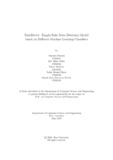| dc.contributor.advisor | Hossain, Muhammad Iqbal | |
| dc.contributor.advisor | Alam, Md. Golam Rabiul | |
| dc.contributor.author | Sraboni, Tasnuba | |
| dc.contributor.author | Uddin, Md. Rifat | |
| dc.contributor.author | Shahriar, Fahim | |
| dc.contributor.author | Rizon, Ruhit Ahmed | |
| dc.contributor.author | Polock, Shakib Ibna Shameem | |
| dc.date.accessioned | 2021-09-06T12:50:15Z | |
| dc.date.available | 2021-09-06T12:50:15Z | |
| dc.date.copyright | 2021 | |
| dc.date.issued | 2021-06 | |
| dc.identifier.other | ID 17301017 | |
| dc.identifier.other | ID 17101016 | |
| dc.identifier.other | ID 21141084 | |
| dc.identifier.other | ID 17101050 | |
| dc.identifier.other | ID 17101435 | |
| dc.identifier.uri | http://hdl.handle.net/10361/14979 | |
| dc.description | This thesis is submitted in partial fulfillment of the requirements for the degree of Bachelor of Science in Computer Science and Engineering, 2021. | en_US |
| dc.description | Cataloged from PDF version of thesis. | |
| dc.description | Includes bibliographical references (pages 33-34). | |
| dc.description.abstract | Information is power although fake information can have severe consequences when
it gets viral. Living in the era of social media is like always getting influenced
by the news of the online world even though it is fake. Moreover, online news
portals and social media are becoming standardized for consuming information. It
is effortless to spread fake news using these mediums. Fake news is represented as
authentic news with the wrapping of inaccurate information. In recent times, the
rate of lynching has increased because of the spread of fake news. Besides, COVID19 related false information is affecting people by creating chaos and spreading
panic worldwide. Some fake news automation systems exist to tackle this problem.
However, they are largely developed for English. There are hundreds of millions of
people who speak Bangla worldwide. In this work, we propose a model that can
favorably detect fake news in Bangla. We have applied some pre-processing and
feature extraction techniques to our dataset. Experimental analysis on real-world
data demonstrates that Passive Aggressive Classifier and Support Vector Machine
achieves 93.8% and 93.5% accuracy respectively which are higher than the other
Machine Learning classifiers. | en_US |
| dc.description.statementofresponsibility | Tasnuba Sraboni | |
| dc.description.statementofresponsibility | Md. Rifat Uddin | |
| dc.description.statementofresponsibility | Fahim Shahriar | |
| dc.description.statementofresponsibility | Ruhit Ahmed Rizon | |
| dc.description.statementofresponsibility | Shakib Ibna Shameem Polock | |
| dc.format.extent | 34 pages | |
| dc.language.iso | en | en_US |
| dc.publisher | Brac University | en_US |
| dc.rights | Brac University theses are protected by copyright. They may be viewed from this source for any purpose, but reproduction or distribution in any format is prohibited without written permission. | |
| dc.subject | Fake News | en_US |
| dc.subject | Bangla Fake News | en_US |
| dc.subject | Machine Learning | en_US |
| dc.subject | NLP | en_US |
| dc.subject | Tf-IDF | en_US |
| dc.subject | Passive Aggressive Classifier | en_US |
| dc.subject.lcsh | Machine learning | |
| dc.title | FakeDetect: Bangla fake news detection model based on different machine learning classifiers | en_US |
| dc.type | Thesis | en_US |
| dc.contributor.department | Department of Computer Science and Engineering, Brac University | |
| dc.description.degree | B. Computer Science | |

